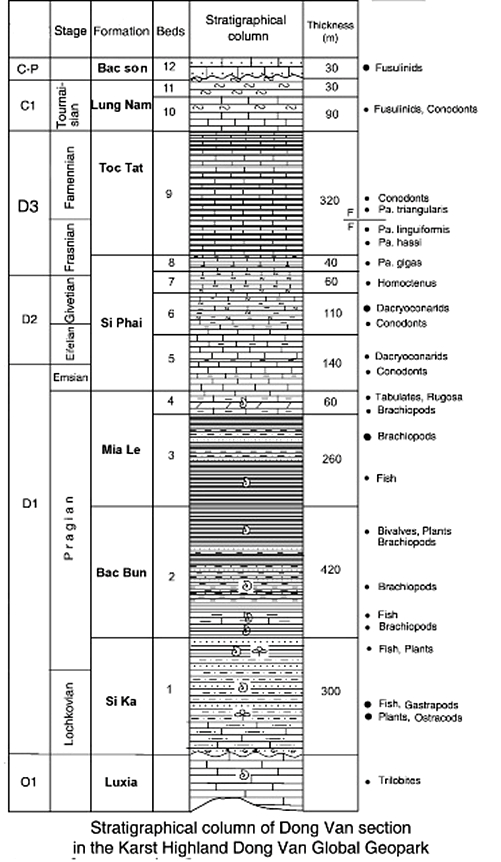Bac Bun Fm
Type Locality and Naming
Middle formation in Song Cao Gr. Holostratotype On the track from Lung Co to Mia Le, in the section extending through Si Ka Pass and Bac Bun Village (N= 23° 18', E= 105° 17'). Deprat J. 1915. Tong-Dzuy Thanh (1979, 1993) established the Bac Bun horizon or regional stage for unifying the sediments containing the Howittia wangi Assemblage in North Viet Nam. The stratotype of this stage is also that of the above-described stratotype of the Bac Bun Fm.
Synonym: Série de Bac-boun: Deprat J. 1915 (Upper Ordovician ); Jacob c., Bourret R. 1920 (Eifelian); Saurin E. 1956 (Emsian). Hệ tầng Bắc Bun:. Tong-Dzuy Thanh et al. 1990 (Lower Devonian); Paris F., Ta Hoa Phuong, Baudu-Suire 1993; Tong-Dzuy Thanh 1993, (in Vũ Khúc et al.) 2000; Tống Duy Thanh 1979 (D1l-p) (Điệp); Tống Duy Thanh et al. 1986,1988, 1989 D1 (Điệp); Nguyễn Hữu Hùng, Đoàn Nhật Trường, Đặng Trần Huyên, 1991 (hệ lớp) (D1). Điệp Bắc Bun (part.): Hoàng Xuân Tình et al. 1976; Vũ Khúc, Bùi Phú Mỹ et ứ/. 1990 (D,). Điệp Sông Cầu (part.): Trần Văn Trị et «/.1964, 1977 (S2-D1); Dương Xuân Hảo et al. 1975, L 980 (D1); Phạm Đinh Long 1968 (D2e). Bậc Eifel (part.): Vasilevskaia E.D. (Dovjikov A.E. et al. 1965); Dương Xuân Hảo et al. 1973. Điệp Bản Rõm (part.): Phạm Đình Long 1967 (D2e). - Hệ tầng Bẳc Mê (part. ?): Tạ Hoàng Tinh 1971 (D1 ?). Điệp Nà Ngần (part.): Phạm Đình Long et al. 1974 (D,), Tống Duy Thanh et al. 1986, 1988 (D1), Đoàn Kỳ Thuỵ et al. 1976 (part.) ( D1). Các trầm tích Devon hạ (part.): Dương Xuân Hảo et al. 1975.
Lithology and Thickness
Claystone, siltstone, shale. (1). Grey, chocolate weathering clayey shale and marly shale, 130 m thick. Marly shale yields plant remains, some phyllocarids, vertebrate Yunnanolepis sp., brachiopod Howittia wangi and bivalve Goniophora sp. (2). Grey, yellowish-brown weathering siltstone, 100 m thick; containing vertebrate remains of Tongdzuylepis vietnamensis and badly preserved brachiopods Lingulida indet. (3). Greenish-grey, variegated (red, yellow, pink, greenish and white) weathering clay shale, 70 m thick. The thickness of the formation in this section reaches 300 m.
[Figure: Mia Lé – Bac Bun – Si Ka Fms: Stratigraphic Column (images courtesy of Prof. Ta Hoa Phuong, Vietnam Natl. Univ. Hanoi)]
[Figure: Si Ka – Bac Bun – Mia Le – Si Phai – Toc Tat StratColumn of DongVanSection in the Karst Highland Van Global Geopark (images courtesy of Prof. Ta Hoa Phuong, Vietnam Natl. Univ. Hanoi)]
Relationships and Distribution
Lower contact
The Si Ka and Bac Bun formations have a conformable relation with one another, and in many sections the lithological composition of the uppermost part of the Si Ka Fm is still close to that of the lowermost part of the Bac Bun Fm,
Upper contact
Conformably below the Mia Le Fm
Regional extent
Similar to the underlying Si Ka Fm, the Bac Bun Fm is widely distributed in East Bac Bo, in Ha Giang, Cao Bang, Lang Son and Thai Nguyen Provinces. In West Bac Bo the equivalents of this formation have been described as components of the upper part of the Song Mua Fm.
GeoJSON
Fossils
Including Howellella mercuri, Howittia wangi, and vertebrate fossils Yunnanolepis cf. praecursor, Y. meemannae, Y. sp., Chuchinolepis cf. Ch. dongmoensis, Zeaspis sp., Nostolepis sp., Langdenia campylognathus, Dipnoi gen. et sp. indet. and Galeaspida gen. et sp.
[Figure: BắC Bun Fm: Brachiopod- Howittia wangi (images courtesy of Prof. Ta Hoa Phuong, Vietnam Natl. Univ. Hanoi)]
Age
Depositional setting
The Bac Bun Fm is characterized by littoral, deltaic facies grading upwards into shallow marine, continental shelf facies. According to the vertebrate paleontologists, the vertebrates in the lower part of the Bac Bun Fm consist of littoral or brackish-water deltaic species.
Additional Information


